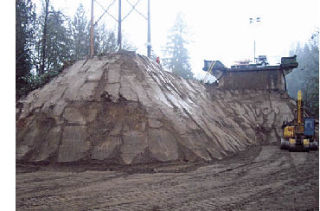Drivers face detours and business owners are losing money, all because of a geologic problem dating back thousands of years.
That was the message delivered to members of the Enumclaw City Council recently by an official with the Washignton State Department of Transportation, who offered an update on the Kummer Bridge closure.
“It was built on the edge of an ancient landslide,” said Russ East, assistant regional administrator for the DOT, adding that the entire southern edge of the Green River Gorge is shifting toward the river. When the span was built in 1932 there was no way engineers could have been aware of the problem, he added.
The DOT has monitored the slide area for more than a decade and were finally forced to take a dramatic step of closing the bridge so extensive work could be done. A pair of “low cost, low impact” repairs in 2008 weren’t doing the job, East said, prompting the closure in November. The shifting hillside has been pushing against the southern pier, threatening the integrity of the entire structure.
The problem is evident when looking at the road approaching the bridge, East said. The road the bridge are not exactly aligned – not by design, but rather due to the movement of the entire hillside.
East made recent appearances in both Enumclaw and Black Diamond, a reflection of the important role the bridge – a part of state Route 169 – plays in area commerce and recreation. It’s not the only way to travel between the two communities, but it’s the shortest and most efficient.
“We know there have been hardships,” East said. “People all along here have gone through an extraordinarily difficult time.”
Jamie Holter, a public affairs officer with DOT, said the department has tried to make the best of the situation. When businesses in the Krain area requested additional signage, she said, the DOT complied.
Since November, East said, work crews have removed 20,000 cubic yards of soil from the southern edge of the bridge, along with a sizable stretch of SR 169. There’s now an abrupt 30-foot drop from the bridge deck to the ground below.
That work, which took the pressure off the bridge pier, was done on an emergency basis, East said, which meant it could be accomplished quickly, without the need for the traditional bid process.
Subsequent work has to be advertised, with bids reviewed and one finally accepted, he said, noting that the slower process is required when federal money is used. It is expected that the bridge won’t be opened until mid-July.
The long-term repairs will involve three measures, East said. A “deep-seated retaining wall” will be built, additional work will be done to keep water draining from the southern edge of the canyon and, finally, the highway will be rebuilt.
When everything is accomplished, East said, “You won’t notice a lot of difference.”
The extensive repair work is coming from federal sources and is expected to tally about $15 million.
City Councilman Jeff Beckwith asked East if there were any incentives being provided to get the project completed earlier, given the fact that July is an important travel time on the Plateau.
East said the contract will call for crews to be working seven days a week, so there was no extra incentive offered to hurry the project along.


